Publication of the Building Safety Bill this month has cranked up the pressure on the industry to speed up reform of technical competence and regulatory compliance, according to the Building Engineering Services Association (BESA).
By more than doubling the period during which clients can seek compensation from contractors for poor quality and unsafe building work, the government has considerably raised the stakes, the association said.
Homeowners will now have up to 15 years to take action over non-compliant work and, because the legislation will be retrospective, the new Building Safety Regulator will be able to take action over many projects that have already been completed even though the Bill does not come into force until 2023.
The legislation will require project teams to consider safety risks at the earliest stage of the planning process and a new Building Safety Regulator will enforce a regime that places responsibility on constructors to pass safety tests at three stages: design, construction and completion.
“We have long talked about the ‘culture change’ envisioned by Dame Judith Hackitt for reforming our industry and this update to the Bill gives us a clearer idea of what that could look like in practice,” said BESA’s director of certification Rachel Davidson. “Many parts of construction and the building engineering sector have, effectively, been unregulated for decades. To really get to grips with that, we would like to see the Bill given real teeth and extended to cover the whole building stock, not just high rise residential. Also, the regulator must be properly funded and resourced so that it can start to deliver the Hackitt vision and deliver the culture change we all recognise is needed. Then we can all start to play our part."
The use of stored data will place another obligation on contractors. The Bill reinforces the need for a mandatory ‘golden thread’ of information created during construction and updated throughout the building’s lifecycle. This will make it clear who did what when and who was responsible for each aspect of the design and delivery.
“The inquiry into the Grenfell Tower disaster has clarified a lot of things we already knew such as the fact that not actually being competent does not always prevent someone from winning a contract,” Rachel Davidson added. “It has also shown that clients often can’t afford the building that has been designed for them. This creates a need to ‘value engineer’, which is code for leaving out parts of the original design in order to cut costs. It will now be much clearer who makes a decision like that and who, therefore, will carry the can; even if it is many years in the future.”
She said the new safety regime promoted by the Bill would also put an end to a culture of awarding projects to “the tenderer who made the biggest mistake” and, therefore, came in at the lowest price.
BESA head of certification Duncan Sibbald said the industry had been forced to go right back to basics in many areas to work out the definition of what competence and compliance looks like. “This is work that is long overdue, but is incredibly wide ranging because the building engineering sector is so diverse. It includes many highly specialised areas that have, effectively, been making up their own definitions of compliance for years,” he said.
He pointed to the ventilation hygiene sector as a case in point where many firms wanted to improve standards and find definitions of best practice that could be regulated and enforced. However, because the sector had been totally unregulated, it had to deal with a ‘cowboy’ element who pushed down prices and carried out sub-standard, unsafe work.
He said BESA’s Ventilation Hygiene Elite (VHE) scheme was an example of how a sector can work together to agree a method for demonstrating compliance in line with an industry-wide standard – in this case TR/19 – so that contractors can provide evidence to clients, insurers and regulators that their work is compliant.

“Kitchen extract cleaning was highlighted as a key fire safety area that was not well regulated long before Grenfell,” Duncan Sibbald said. “By working together, we have been able to deliver a competence and compliance regime that has helped to raise the professionalism of a whole sector and make a massive difference to building safety.”
“Of course, there will always be people looking to cut corners, but they are rapidly becoming the minority. In the main we have found that companies want to do the right thing and agree on a standard that everyone can work towards to keep people safe in buildings,” he said.
He also cited the Construction Skills Certification Scheme (CSCS) regime as another area where multiple organisations collaborated to produce a set of standards and qualifications for working safely and competently on site. There are 38 partner schemes under the CSCS umbrella covering an industry-wide compliance regime that all responsible firms work towards.
BESA administers the Engineering Services SKILLcard, which is one of the CSCS Partner card schemes. It is used by more than 60,000 people working in the heating, ventilating, air conditioning and refrigeration sectors. CSCS logoed cards only certify occupations with nationally recognised construction related qualifications, such as NVQs or approved equivalents, to ensure workers have the right qualifications for the job in hand and have suitable health and safety training.
“One of the biggest challenges with delivering Hackitt’s vision is creating proper definitions of the many separate roles and responsibilities so that everyone is clearly aware of what is expected of them,” Duncan Sibbald said. “BESA has been in the vanguard of this work, but we cannot come up with the definitions on our own – so we are working right across the industry on this and there is still a long way to go. We don’t have all the answers, but we are working closely with member companies and other like-minded organisations to establish definitions of best practice and compliance. Then it is up to bodies like BESA and others to offer training that meets that standard and companies to invest in their people to ensure they are competent.”
The SFG20 maintenance standard developed by BESA is another collaborative exercise involving a range of sector bodies and practitioners and seeks to provide solutions to support the ongoing operation of buildings in line with the Hackitt Review.
“The amount of work required in collating and managing building information – particularly with legacy buildings that do not have digitised information or lack complete records – cannot be underestimated,” said SFG20’s head of business development, Steve Tomkins.
“The scope of the Grenfell inquiry is specific to high-rise residential dwellings, but I can see this quickly becoming the basis for all building information management and control. SFG20 has already set out on this journey by helping to simplify the language and structure used by different disciplines to describe and classify building assets.”
In preparation for the major changes enshrined in the Bill, BESA has also revised its Competence Assessment Standard – the system it uses to assess the suitability of firms for membership. It involves auditing their technical and behavioural competence and ability to comply with industry best practice and building regulations.
The association is also a signatory of the government-backed Building a Safer Future Charter, which was one of the initiatives to emerge from the Hackitt Review. Signatories must demonstrate how they are putting people’s safety first in the planning, design, construction, and maintenance of buildings. The charter was launched by a group of local authorities, contractors, housing associations and property developers, with the support of the Ministry of Housing, Communities & Local Government (MHCLG).
By signing the charter, BESA made a number of serious commitments including:
- agreeing to collaborate to deliver culture change across the built environment sector;
- to put the safety of people at the centre of decision making by the Association and its members;
- to being transparent in the interest of safety;
- ensuring there are clear competence requirements for companies and people;
- refusing to allow any compromise on quality or value for money that could undermine safe practices;
- to set out and communicate clear responsibilities within its own organisation.
“Signing the charter was not an empty gesture,” said Rachel Davidson. “The general public has lost its confidence in the construction industry for very good reasons. We all must be fully transparent in what we do and provide measures against which we can be judged and held accountable. This commitment is already proving to be good practice for the new regulatory regime and, as the updated Bill shows, there will be no hiding place for anyone who tries to ‘game’ the system.”
Got a story? Email news@theconstructionindex.co.uk




